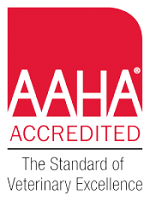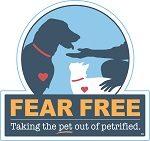During your pet’s life time, it is likely that there will come a point where a dental cleaning under anesthesia is needed. This can often cause pet parents to feel anxiety about having their pet put under anesthesia. This blog post details the safety precautions we take and gives an overview of exactly what a dental cleaning involves.
Your pet will need to stay with us for a good part of the day when he/she has the dental procedure. An admit appointment with a technician will be made for the morning of the dental, to go over paperwork and answer any questions that you may have.
After you leave, your pet will be housed in a cozy hospital cage with comfy blankets. The technician will shave an area on your pet’s front leg in preparation for an IV catheter. A numbing gel will be put on the shaved area so that the catheter placement will not cause pain. After 5-10 minutes the IV catheter will be placed in preparation for the procedure. If preanesthetic bloodwork was not done prior to the dental appointment, blood will be drawn to perform this in clinic at this time. Preanesthetic bloodwork can go a long way in helping to ensure the safety of anesthetic for your pet.
Prior to the veterinarian’s preanesthetic exam, your pet will be put back into the hospital cage to relax for awhile. For anxious pets, calming music will be played to help reduce anxiety. Dog or cat specific pheromone spray is used to help promote a low stress level as well.
Once the IV catheter has been placed and bloodwork has been completed and reviewed by the DVM, a preanesthetic exam is performed to check your pet over one last time prior to anesthesia. At this time injectable preanesthetic drugs to promote a state of calm are given in preparation for full anesthesia. While these drugs are taking effect the technician will do a final check of the dental suite to make sure everything is properly prepared for your pet’s procedure. Once everything is ready the dental procedure is completed as follows:
- Your pet is placed on a plush, thick flexible pad on the dental wet table to ensure your pet’s comfort during the procedure.
- An injectable anesthetic agent is given to your pet via the IV catheter that was place earlier. This completely relaxes your pet and makes them unconscious so that an endotracheal tube can be placed.
- Your pet is snuggled between two warming devices to keep them cozy and warm and maintain body temperature throughout the dental procedure.
- Your pet is now put on oxygen and an inhalant anesthesia (isoflurane) throughout the procedure. Inhalant anesthesia is very safe and can be adjusted up or down depending on anesthetic depth.
- IV fluids to maintain hydration, blood pressure and help support the kidneys is started and will be continued for the duration of the procedure.
- Your pet will have an ECG, temperature probe, oxygen sensor and CO2 monitor placed so important parameters can be carefully monitored.
- Full mouth dental radiographs are performed to look at each tooth and it’s roots. This tells the veterinarian what is going on under the gum line. This part is very important as it helps detect abscesses or decay, resorptive lesions, bone loss, abnormal roots, retained teeth and more. Many of these problems are not visible above the gum line and would go undetected if dental x-rays are not performed.
- Each tooth will be examined for abnormalities and pocket depth is measured. A detailed dental chart is made showing all problems whether severe or just beginning. This can help greatly in the future to compare and see if problem areas are worsening. You will receive a copy of this dental chart when your pet goes home.
- Each tooth will be thoroughly cleaned and polished. An antimicrobial dental wash will be used to help reduce any existing bacterial load. Tartar will be removed and an ultrasonic cleaning wand and specialized dental tools will be used to clean all surfaces including areas accessible under the gum line.
- The veterinarian will evaluate the teeth and radiographs and will determine if extractions are needed. Teeth that are mobile are often removed fairly easily, however larger teeth with multiple roots can take specialized tools, patience and skill to remove. In many cases absorbable sutures are placed to close the extraction site.
- Once everything has been completed, your pet will receive injectable pain medication if needed.
- Your pet will be taken off of the inhalant anesthesia to begin the process of waking up. All monitoring equipment, IV fluids, oxygen and warming devices are kept in place until your pet is awake for safety and comfort.
- Once your pet is sufficiently awake and breathing on their own, your pet’s endotracheal tube will be gently removed. Pet’s with kidney issues may be kept on IV fluids for a couple of hours after the procedure is completed. Most pets without underlying conditions will have IV fluids stopped at this point.
- Your pet will be placed into their hospital cage with plush blankets and warming discs and will be carefully monitored throughout recovery.
- The veterinarian will call you to let you know how things went, what issues if any were found and to verify pickup time.
- At the release appointment, the technician will go over details of the procedure, at home instructions and the dental chart. They will also talk to you about at home toothbrushing or maintenance recommended to keep the teeth clean going forward.
Your pet’s health and safety is always our biggest concern when doing dental procedures. Every precaution is taken to ensure safety and comfort while addressing any dental pain or abnormalities that may be occurring. Your pet is not able to verbally tell us when they are experiencing dental pain or discomfort. Most pets will just cope with dental pain and usually do not show any outward signs. The hunger drive is strong and pets will continue to eat even with severe dental disease. Detecting and addressing dental problems when they occur is so important in maintaining your pet’s health and quality of life.




